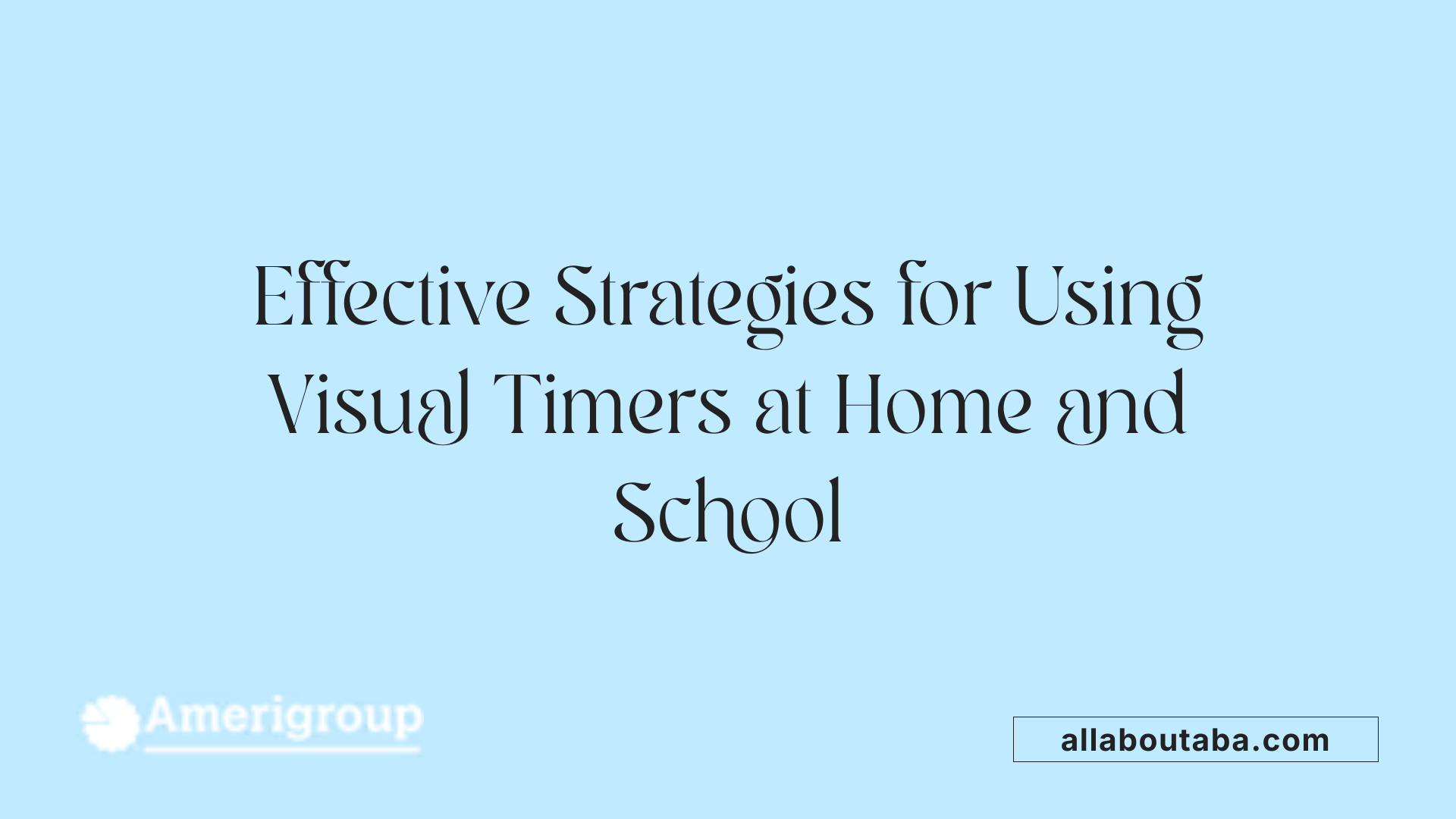Introduction to Visual Timers and Their Role in Autism Support
Effective time management is a crucial aspect of supporting individuals with autism, helping reduce anxiety, foster independence, and improve daily routines. Visual timers have emerged as powerful tools in this regard, providing clear, visual cues that quantitatively and qualitatively illustrate the passage of time. This article explores the benefits of using visual timers for autism, strategies for their implementation, and the available types that best meet individual needs.
Understanding the Benefits of Visual Timers for Autism

What are the benefits of using visual timers for individuals with autism?
Visual timers are powerful tools that help individuals with autism better understand and manage their daily routines by providing a clear, visual representation of time passing. These timers use visual cues such as moving disks, changing colors, or countdown graphics to signal how much time remains for an activity. This visual approach makes the abstract concept of time more concrete, which is especially helpful for those who struggle with traditional time perception.
One of the main advantages of these timers is their ability to reduce anxiety related to transitions and unknowns. By seeing a timer count down, individuals can anticipate upcoming changes, helping them prepare mentally and emotionally. Reduced uncertainty often leads to calmer behavior and smoother transitions between tasks.
In addition, visual timers support task completion and improve focus. They motivate users to stay engaged until the timer signals the end of an activity. This encouragement can promote independence, as individuals learn to monitor their own progress and manage their time effectively.
Furthermore, visual timers assist in developing essential planning skills. By estimating activity durations and comparing them with actual time, individuals can calibrate their perception of how long tasks take. This process enhances their ability to plan future activities more accurately.
The versatility of timers, including countdown timers, sensory timers, and adjustable models, allows customization to fit various sensory preferences and needs. For example, timers with bright colors or gentle alerts can be more suitable for individuals with sensory sensitivities.
Overall, integrating visual timers into routines helps foster confidence, independence, and self-regulation. They serve as essential supports in therapy, classroom, and home settings, making daily life more predictable and manageable for individuals on the autism spectrum.
How do visual timers impact anxiety and task completion?
Visual timers significantly reduce anxiety in individuals with autism by providing visual cues that clarify how long an activity will last and when it will end. Knowing exactly when a transition will happen helps alleviate fears of the unknown, making changes less stressful.
These timers also promote better task completion rates. When users see how much time is left, they are more motivated to stay focused and work efficiently, leading to increased productivity and a sense of accomplishment.
Supporting independence and planning with timers
Timers serve as visual anchors that can teach independence. Children and adults can learn to initiate and complete tasks without constant adult prompts. Over time, they develop skills in estimating durations, managing time, and understanding schedules.
Sensory considerations and timer customization
Different individuals have unique sensory profiles. For some, a visual timer with bright colors and gentle sounds is stimulating, while others may prefer silent or softly ticking timers to avoid overload.
Adjustable timers that can be set to different durations and features like visual alarms or vibration ensure that each person’s preferences are met, making timers more effective and engaging.
Incorporating visual timers into daily routines—alongside visual schedules and social stories—creates a comprehensive framework that supports better understanding of time, smoother transitions, and enhanced autonomy.
Implementing Visual Timers in Educational and Home Environments

Strategies for effective implementation
Using visual timers in daily routines can significantly improve understanding of time and reduce anxiety for individuals with autism. To implement them effectively, integrate timers consistently into activities and transitions, making them a familiar part of the environment. For example, during homework, chores, or waiting periods, the timer provides a clear visual cue indicating how much time remains. This helps children anticipate upcoming changes, promoting smoother transitions and increased independence.
In classrooms and homes, pairing timers with visual schedules enhances predictability. When children see both the schedule and the timer, they better understand what to expect next, creating a structured environment that fosters confidence and self-regulation.
Integration with visual schedules and routines
Timers work best when combined with visual schedules that show the sequence of activities in a day. For example, a picture schedule for a morning routine can be used alongside a countdown timer to signal when a particular task should be completed. This combination allows children to visually connect time with activity expectations, fostering a sense of control and reducing stress.
Timers can also be used to break larger tasks into smaller segments, each with its own visual timer. This approach helps manage complex activities by giving a sense of progress and accomplishment.
Choosing appropriate timer types for individual needs
Different individuals have unique sensory and motor preferences, influencing the choice of timer. Visual timers come in various forms—such as large, high-contrast disks like the Time Timer, digital countdown timers, or physical objects like sand timers.
For children with sensory sensitivities, quiet timers without loud alarms or flashing lights are preferable. For those who benefit from auditory cues, timers with gentle sounds or alarms can be effective. It’s essential to select timers that match the child's developmental level; for example, simple visual cues may suit younger children or those with cognitive delays.
Popular options include the Time Timer Plus 120 Minute for longer durations and the compact Time Timer Original 8″ for shorter activities. These models are known for their visual clarity and quiet operation, making them suitable for sensory-sensitive users.
Consistency and customization in use
Consistent use of timers helps establish routines and predictability, which are crucial for individuals with autism. Customizing timer settings and visual cues to fit individual routines ensures each person benefits fully. For instance, adjusting timer length based on the task, or incorporating familiar visuals or colors, can make timers more engaging and easier to understand.
Regularly reviewing timer effectiveness and making necessary adjustments helps maintain their usefulness as a supportive tool. Encouraging independence by teaching children to set and interpret timers fosters self-monitoring skills, building confidence over time.
By thoughtfully integrating visual timers into daily routines with appropriate customization, educators and caregivers can support individuals with autism in developing essential time management and transition skills that lead to greater independence and reduced anxiety.
Types of Visual Timers Suitable for Autism Management

What types of visual timers are suitable for autism management?
A variety of visual timers are designed to meet the unique needs of individuals with autism, helping them better understand and manage time. Among these, digital and analog timers are popular choices.
Digital timers often feature clear displays with digital countdowns, alarms, and customizable visual cues such as colors, shapes, or animations. These options can be tailored to suit different sensory sensitivities and preferences. Analog timers, like the Time Timer devices, use a tangible red disk that diminishes as time passes, providing a simple yet effective visual cue of remaining time.
Physical timers, including sand timers, oil timers, gel timers, and lava-lamp-like timers, offer tactile and visual engagement without requiring electricity. They are portable, easy to use, and can serve as calming tools during transition times. These timers help children physically see and feel the passage of time, reducing uncertainty.
App-based timers are accessible on smartphones and tablets and can be highly customizable. They support visual, auditory, and tactile cues, allowing users to tailor the experience. Features like color-coded countdowns, visual graphics, and optional sounds help improve understanding and focus.
Features such as visual cues (colors, shapes, moving graphics), alarms, and countdowns are crucial. Visual cues can include a shrinking disk, changing colors, or visual representations of time passage, making abstract concepts concrete.
Overall, the choice of timer depends on individual sensory needs, setting, and goals. Combining these tools with visual schedules or social stories enhances the ability of children and adults with autism to manage transitions, stay focused, and develop greater independence.
How Visual Timers Support Children in Gauging and Tracking Time

How do visual timers help children with autism gauge and track time?
Visual timers are effective tools that aid children on the autism spectrum in understanding and managing time. They use clear visual cues, such as a colored disk that gradually shrinks or graphics that move to indicate the passage of time. These visual cues turn the abstract idea of time into something concrete and visually accessible.
For example, a timer might feature a red disk that slowly disappears, showing how much time is left for an activity. This helps children see the remaining duration at a glance, reducing uncertainty and anxiety. The visual nature of these timers makes it easier for children to anticipate when an activity will end or when a transition will occur.
In addition to visual cues, many timers come with auditory alerts or vibrations that signal the end of a countdown. These features cater to children with different sensory needs, reinforcing the concept of time passing.
By providing a visual representation of time, timers promote independence. Children learn to manage their expectations and stay on schedule without constant adult prompts. They can also develop better skills in estimating how long tasks take, which is crucial for planning daily routines.
Overall, visual timers support children in building a better understanding of time, helping them become more self-sufficient in managing transitions and completing activities. This reduces stress, enhances routine adherence, and encourages autonomy, making daily life more predictable and less overwhelming for children with autism.
Practical Applications of Visual Timers in Daily Routines
What practical applications do visual timers have in routines and daily activities for individuals with autism?
Visual timers are versatile tools that significantly improve daily routines for individuals with autism by making the passage of time tangible and understandable. They provide visual cues, such as a shrinking disk or countdown indicators, which help users gauge how much time remains for a given activity. This visual representation makes routines more predictable, reducing anxiety associated with transitions and timing.
In practice, visual timers are commonly used to manage transitions between activities, such as moving from playtime to mealtime or from classroom lessons to breaks. They signal to individuals when an activity is about to end, enabling better preparation and smoother shifts without sudden surprises.
These timers are also helpful in supporting independence when completing tasks. For example, children can see and track how long they’ve been working on homework, chores, or personal care routines, fostering a sense of control and self-monitoring.
Furthermore, visual timers can set clear boundaries for preferred activities like screen time, helping children understand the duration allotted for gaming or TV viewing. This often leads to increased compliance and a better understanding of time limitations.
By integrating visual timers into daily schedules, caregivers and educators create a structured environment that promotes consistency, enhances focus, and builds self-regulation skills. Whether used at home, in school, or therapy settings, these tools support a calm, organized routine where individuals with autism can thrive.
| Application Area | Description | Benefits |
|---|---|---|
| Managing transitions | Signals end/start of activities to prepare child | Smoother changes, reduced stress, less meltdowns |
| Supporting task completion | Tracks time spent on tasks like homework or chores | Improved independence, self-regulation |
| Reinforcing activity durations | Limits screen time or preferred activities | Better understanding of time, increased control |
| Promoting routine predictability | Offers visual cues for daily schedules | Fewer surprises, enhanced routine adherence |
Overall, visual timers serve as effective time management aids that foster independence, reduce anxiety, and help individuals with autism develop valuable self-regulation and planning skills.
Scientific Evidence Supporting the Use of Visual Timers
 Research supports the effectiveness of visual timers as valuable tools for individuals with autism. Multiple studies have demonstrated that these timers can significantly reduce anxiety associated with transitions and unfamiliar activities. For example, a study by Florida Atlantic University found that children aged 2-4 showed improved self-regulation skills when using visual timers, helping them better manage their emotions and behaviors.
Research supports the effectiveness of visual timers as valuable tools for individuals with autism. Multiple studies have demonstrated that these timers can significantly reduce anxiety associated with transitions and unfamiliar activities. For example, a study by Florida Atlantic University found that children aged 2-4 showed improved self-regulation skills when using visual timers, helping them better manage their emotions and behaviors.
Visual timers also assist in completing tasks more efficiently. By providing a clear visual cue of how much time remains, they help users stay focused and motivated. This is particularly beneficial for children and adults who struggle with time estimation, such as those with autism, who often have altered perceptions of time.
The positive effects extend to supporting routine adherence and independence. Timers act as visual anchors during daily routines, helping individuals anticipate changes and transitions smoothly. This predictability minimizes stress and meltdowns, fostering greater autonomy.
From a neurological perspective, understanding time involves complex brain mechanisms, including the basal ganglia and cerebellar systems. In individuals with autism, these systems may process time differently, leading to challenges in gauging and tracking time. Visual timers compensate for these differences by providing concrete, visual representations of time passing, which can aid in recalibrating their perception.
Overall, research indicates that visual timers are supported by behavioral and neurological evidence as effective tools in improving focus, managing anxiety, and building independence among people with autism.
How Visual Timers Alleviate Stress and Promote Routine Compliance
Reducing anxiety through visual cues
Visual timers provide concrete visual signals about the passage of time, which is especially helpful for individuals with autism. The disappearing disk or color-changing features visually represent how much time remains, helping to make an abstract concept more tangible. This reduces feelings of uncertainty and overload, which can trigger anxiety.
Signaling transitions and activity completions
Timers act as visual cues to indicate upcoming transitions or the end of an activity. For example, a changing color or countdown can alert individuals that it's time to switch tasks or prepare for a break. This helps them anticipate changes, decreasing resistance and meltdowns caused by surprise or unpredictability.
Providing predictability and structure
Establishing routines is critical for individuals with autism. Visual timers help reinforce daily schedules by offering a predictable structure. When used alongside visual schedules or charts, timers clearly show how long each activity will last, fostering a sense of order and control.
Supporting self-regulation and independence
With a visual timer, individuals can self-monitor their progress through activities. This fosters independence, as they learn to manage their time without constant adult supervision. Over time, the consistent cues from timers help improve time awareness and self-regulation skills, leading to better focus and task completion.
Research shows that these visual tools significantly reduce stress and promote adherence to routines. By turning the passage of time into a visual, understandable concept, timers empower individuals with autism to navigate daily activities more confidently and calmly.
Adapting Visual Timers for Adult Autistic Users
Can visual timers be adapted for adult users with autism?
Absolutely, visual timers are versatile tools that can be customized for adults on the autism spectrum to meet their specific needs. These adaptations often include larger, more prominent displays that are easier to see from a distance, which is particularly helpful for older users or those with visual sensitivities.
Many adult-oriented timers offer adjustable visual prompts, such as changing colors, shapes, or visual patterns that can be personalized to suit individual preferences. These features make it easier for adults to interpret the passage of time independently and reduce unnecessary anxiety.
Integration into personalized routines is another significant benefit. Visual timers can be incorporated into daily schedules, assisting with time blocking for work, self-care, and leisure activities. When combined with digital calendars and task management apps, they create a cohesive system that enhances organization and planning.
Promoting independence and confidence is central to using adaptive visual timers. By providing clear visual cues about upcoming deadlines or activity durations, these timers empower adults to manage their time better, adhere to schedules, and reduce reliance on external prompts.
Examples of suitable timer options include larger display models like the Time Timer Plus 120 Minutes, which offers extended visual tracking for longer tasks, and the Time Timer Original 8" with its straightforward, quiet operation. These are designed with sensory sensitivities in mind and can be easily integrated into home or workplace routines.
To sum up, with thoughtful customization and adaptation, visual timers are effective tools to support autistic adults in leading more independent and organized lives. They serve not only as time management aids but also as confidence-boosting devices that help navigate daily challenges with less stress and more autonomy.
Conclusion: The Future of Visual Timers in Autism Support
Incorporating visual timers into routines and environments for autistic individuals offers a practical, evidence-based approach to improving time awareness, reducing stress, and fostering independence. As technology advances, so do the opportunities for customization and integration, making these tools even more accessible and effective. Educators, therapists, and caregivers are encouraged to explore the variety of visual timers available and tailor their use to meet individual needs, promoting more structured, predictable, and supportive environments that empower those on the autism spectrum to thrive.
References
- Time Management For All Abilities | Visual Timer
- Autism and time management
- The Power Of Visual Timers: A Game-Changer - Life Skills Advocate
- How Autism Affects Time Management & Ways to Improve It
- How Can Timers Help Autistic Kids Follow Routines - Gracious Growth
- Time Management Made Easier: The Benefits of Timers for Children ...
- Visual Timer for Children and Adults with Autism
- 7 Effective Time Management Strategies for Autism







